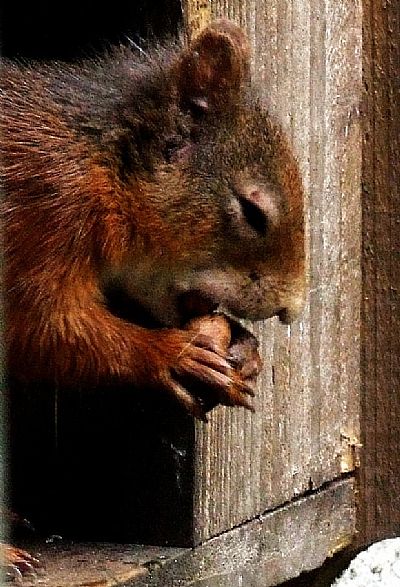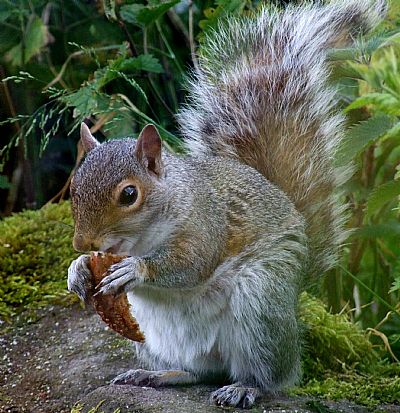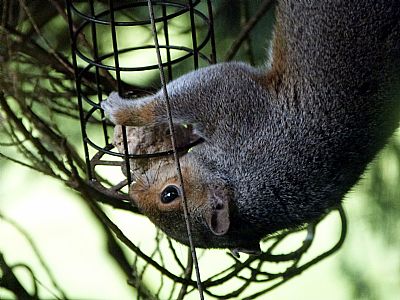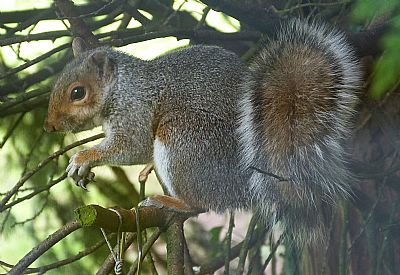SQUIRRELS
There are two species of squirrel in Scotland. However only one is a native species; the Red Squirrel. The Grey Squirrel has been introduced.
The grey squirrrels are seen as a threat to the smaller red squirrels, mainly due to their ability to get at the best food first and chasing off their smaller counterparts. The greay squirrel was introduced from North America in the late 19th and early 20th century. The grey squirrel out-competes the smaller, more specialised red squirrel across much of its range. Once widespread, our native species was soon lost from most of England and Wales - adding more importance in Scotland to protect it and its environment.
According to NatureScot : Grey squirrels also brought with them diseases that presented new threats to red squirrels, most notably squirrelpox. Fatal to red squirrels, this virus is currently found only in south Scotland. But it has proved very hard to contain and the rest of the Scottish population is at risk. Squirrelpox is possibly the single greatest risk to the future of red squirrels in Scotland.
See the Saving Scotland's Red Squirrels survey website link below. The website includes an interesting map of their known distribution.
RED SQUIRREL : SCIURUS VULGARIS
This writer has never seen a red squirrel in West Dunbartonshire. However he has seen them not that far away near Cardross, up Darleith Road in the rurual area. The Saving Scotland's Red Squirrels website (See link below), gives a slightly more optimistic picture with sightings around Balloch Park and over the hill to the west near Cardross. Whether this is the same squirrel being seen more than once or several squirrels is unknown. The same website also has a graph. A peek in sightings occurred in 2020, but that has dipped dramatically since then.
The red squirrel has a hard time when confronted by the larger grey squirrel.
Red squirrels do not hibernate, but they do keep stores of food to see them through difficult times when fresh food is not available. In their favoured habitats of mixed broadleaf and coniferous woodland, they have a source of food all year round, as pine seeds are present over the winter months

Being rather elusive, even if we did find a red squirrel around here, it would be very difficult to photograph. This one was taken near Killicrankie.
GREY SQUIRREL : SCIURUS CAROLINENSIS
The grey squirrel can be found locally in wooded areas, gardens and parks. They can even be see scurrying up rough cast or stone house walls and across the roof. Bird table are popular. It is much larger than the red squirrel and has grey fur and ears without tufts.
Besides bird food. they feed on such things as hazelnuts by cracking the shell in half or pine cones which they nibble, leaving what looks like an apple core behind. Squirrels make a rough nest, called a ‘drey’, of twigs, leaves and strips of bark in the fork of a branch, high in the tree canopy.

This one was taken near Renton enjoying a bread crust.

Some people consider grey squirrels as pest and discourage them from feeding at the bird feeder, but others find them endearing. Eating upside down is no problem to a squirrel - this one hangs by its back feet to reach a fat ball at the bottom of the bird feeder.

FORESTRY AND LAND website : https://forestryandland.gov.scot/learn/wildlife/red-squirrel#:~:text=Red%20squirrel%20%28Sciurus%20vulgaris%29%20Where%3A%20might%20be%20spotted,and%20Dumfries%20and%20Galloway.%20When%3A%20all%20year%20round.
NATURE SCOTLAND : https://www.nature.scot/plants-animals-and-fungi/mammals/land-mammals/red-squirrel
SAVING SCOTLAND'S RED SQUIRRELS survey website : https://scottishsquirrels.org.uk/squirrel-sightings/
SCOTTISH WILDLIFE TRUST : https://scottishwildlifetrust.org.uk/species/grey-squirrel/ & https://scottishwildlifetrust.org.uk/species/red-squirrel/#:~:text=The%20red%20squirrel%20is%20most%20often%20found%20in,of%20hair%20on%20the%20end%20of%20the%20ears.

